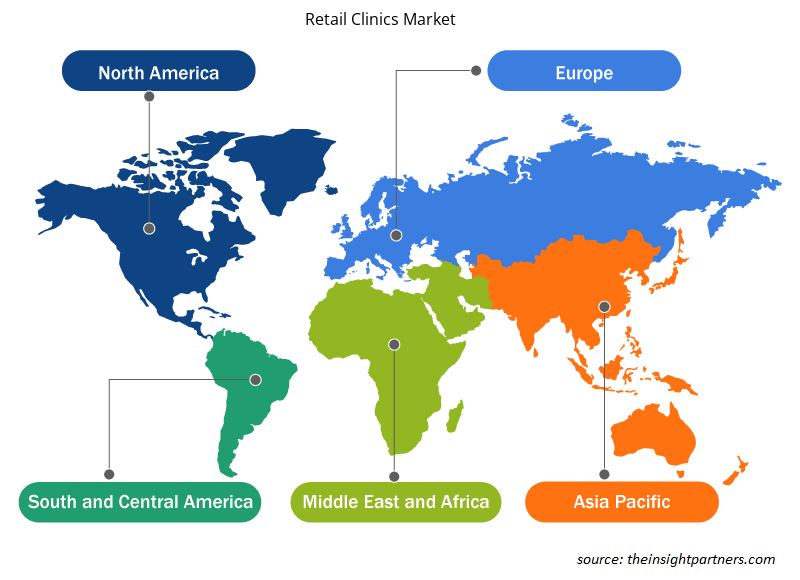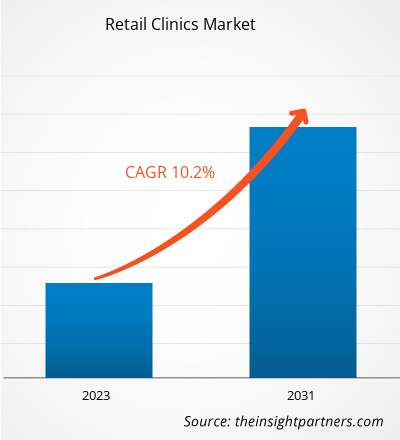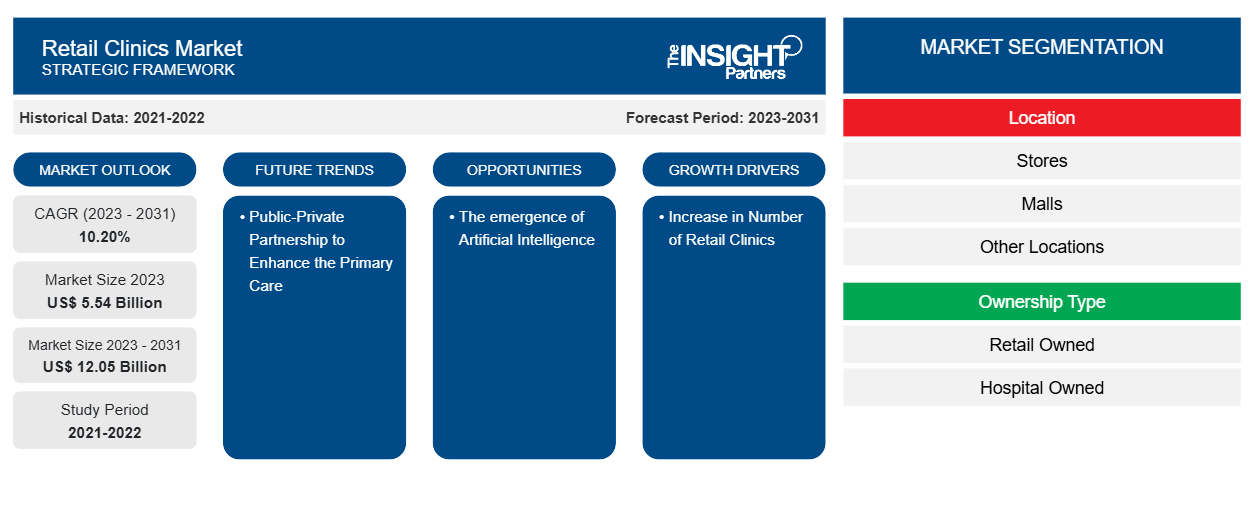Der Markt für Einzelhandelskliniken soll von 5,54 Milliarden US-Dollar im Jahr 2023 auf 12,05 Milliarden US-Dollar im Jahr 2031 anwachsen. Der Markt wird voraussichtlich zwischen 2023 und 2031 eine durchschnittliche jährliche Wachstumsrate (CAGR) von 10,20 % verzeichnen. Die Einführung künstlicher Intelligenz dürfte ein wichtiger Markttrend für Einzelhandelskliniken bleiben.CAGR of 10.20% in 2023–2031. The emergence of artificial intelligence is likely to remain a key retail clinics market trend.
Marktanalyse für Einzelhandelskliniken
Einzelhandelskliniken werden als kostengünstigere Alternative zur Notfallversorgung bei nicht dringenden Fällen vorgeschlagen. Bis zu 20 Prozent der Notaufnahmebesuche bei nicht dringenden Fällen werden als angemessen für Einzelhandelskliniken oder Notfallversorgungseinrichtungen angesehen, wodurch potenziell Kosteneinsparungen von bis zu 4,4 Milliarden US-Dollar pro Jahr möglich sind. In der Gesundheitsbranche werden Einzelhandelskliniken immer wichtiger. Transparente Preise und Erreichbarkeit außerhalb der Öffnungszeiten sind die wichtigsten Faktoren, die das Wachstum beeinflussen.
Marktübersicht für Einzelhandelskliniken
Die Anwendung künstlicher Intelligenz (KI) im Gesundheitswesen – einschließlich Einzelhandelskliniken – nimmt zu. KI kann bei der Terminplanung, der Patiententriage und der Entscheidungsunterstützung von Ärzten helfen. Kliniken können mithilfe dieser Technologie die Patientenzufriedenheit verbessern, den Verwaltungsaufwand verringern und Abläufe rationalisieren. Als Reaktion auf die sich ändernden Bedürfnisse im Gesundheitswesen beginnen Einzelhandelskliniken, spezialisiertere Dienstleistungen wie die Behandlung chronischer Krankheiten und die Unterstützung der psychischen Gesundheit anzubieten. Die oben genannten Faktoren beeinflussen das Wachstum des Marktes für Einzelhandelskliniken
Passen Sie diesen Bericht Ihren Anforderungen an
Sie erhalten kostenlos individuelle Anpassungen an jedem Bericht, einschließlich Teilen dieses Berichts oder einer Analyse auf Länderebene, eines Excel-Datenpakets sowie tolle Angebote und Rabatte für Start-ups und Universitäten.
-
Holen Sie sich die wichtigsten Markttrends aus diesem Bericht.Dieses KOSTENLOSE Beispiel umfasst eine Datenanalyse von Markttrends bis hin zu Schätzungen und Prognosen.
Markttreiber und Chancen für Einzelhandelskliniken
Zunahme der Zahl von Einzelhandelskliniken begünstigt den Markt
Das patientenzentrierte medizinische Zuhause wird als Mittel zur Bereitstellung einer umfassenden, gut geführten Grundversorgung immer beliebter. Gleichzeitig hat die Anzahl der Einzelhandelskliniken erheblich zugenommen. Es gibt wachsende Unterstützung für das patientenzentrierte medizinische Zuhause, um die Versorgung besser zu koordinieren, die Qualität zu verbessern, Kosten zu sparen und der Grundversorgung neues Leben einzuhauchen. Die Anzahl der Einzelhandelskliniken, die eine zugängliche Versorgung für kleinere, akute Erkrankungen anbieten, ist dramatisch gestiegen, und das Konzept des medizinischen Zuhauses hat an Popularität gewonnen. Eine zunehmende Beliebtheit von Einzelhandelskliniken führt also zu einer Zunahme der Anzahl der Kliniken und treibt so das Marktwachstum an. Laut Definitive Healthcare, LLC. waren beispielsweise im März 2023 1.801 Einzelhandelskliniken in Betrieb, verteilt auf 44 Bundesstaaten. Der Mittlere Westen (27,7 %) und der Südosten (34,1 %) sind die Heimat der meisten Einzelhandelskliniken in den Vereinigten Staaten. Im Westen gibt es die wenigsten Einzelhandelskliniken (9,5 %).
Öffentlich-private Partnerschaft zur Verbesserung der Primärversorgung – eine Chance auf dem Markt der Einzelhandelskliniken
Kommunen und Landesregierungen können den Zugang zur Grundversorgung verbessern und die wirtschaftliche Entwicklung fördern, indem sie im Rahmen öffentlich-privater Partnerschaften mit Einzelhändlern und Einzelhandelskliniken zusammenarbeiten. So kündigte BARDA im Februar 2024 über das Rapid Response Partnership Vehicle (RRPV) eine neue Partnerschaftsmöglichkeit im Rahmen des Projekts NextGen an, die darauf abzielt, eine bessere Datenerfassung zum Korrelat des Schutzes (CoP) von Impfstoffen zu ermöglichen und Lösungen für dezentrale klinische Studien (DCT) zu beschleunigen. BARDA sucht einen Partner für seine erste klinische Studie, die nur in einer Einzelhandelsklinik oder einer Apotheke durchgeführt wird.
Segmentierungsanalyse des Marktberichts für Einzelhandelskliniken
Wichtige Segmente, die zur Ableitung der Marktanalyse für Einzelhandelskliniken beigetragen haben, sind Standort, Eigentumsart und Anwendung.
- Basierend auf dem Standort ist der Markt für Einzelhandelskliniken in Geschäfte, Einkaufszentren und andere Standorte unterteilt. Das Segment Geschäfte hatte im Jahr 2023 einen größeren Marktanteil.
- Basierend auf der Eigentumsform ist der Markt in Einzelhandelseigentum und Krankenhauseigentum segmentiert.
- Hinsichtlich der Anwendung ist der Markt in klinische Chemie und Immunassays, Point-of-Care-Diagnostik, Impfung und andere Anwendungen segmentiert.
Marktanteilsanalyse für Einzelhandelskliniken nach Geografie
Der geografische Umfang des Marktberichts für Einzelhandelskliniken ist hauptsächlich in fünf Regionen unterteilt: Nordamerika, Asien-Pazifik, Europa, Naher Osten und Afrika sowie Südamerika/Süd- und Mittelamerika.
In Nordamerika befindet sich der Markt für Einzelhandelskliniken derzeit in der Wachstumsphase und verzeichnet ein exponentielles Wachstum. Die USA dominierten den Markt im Jahr 2023 aufgrund der zunehmenden Popularität und Verfügbarkeit von Einzelhandelskliniken. Beispielsweise sind CVS, Walgreens und Walmart die wichtigsten Einzelhandelskliniken in den USA. Sechs Gruppen kontrollieren neunzig Prozent der Einzelhandelskliniken. Mit mehr als der Hälfte aller Einzelhandelsklinikstandorte ist der Apothekenriese CVS der prominenteste Akteur des Landes. Das Unternehmen, das auch einen Apothekenleistungsmanager (Caremark) und einen Zahler (Aetna) besitzt, stieg 2006 in die Einzelhandelsklinikbranche ein, als es MinuteClinic, ehemals QuickMedx, kaufte.
Regionale Einblicke in den Markt für Einzelhandelskliniken
Die regionalen Trends und Faktoren, die den Markt für Einzelhandelskliniken während des Prognosezeitraums beeinflussen, wurden von den Analysten von Insight Partners ausführlich erläutert. In diesem Abschnitt werden auch die Marktsegmente und die Geografie von Einzelhandelskliniken in Nordamerika, Europa, im asiatisch-pazifischen Raum, im Nahen Osten und Afrika sowie in Süd- und Mittelamerika erörtert.

- Erhalten Sie regionale Daten zum Markt für Einzelhandelskliniken
Umfang des Marktberichts zu Einzelhandelskliniken
| Berichtsattribut | Details |
|---|---|
| Marktgröße im Jahr 2023 | 5,54 Milliarden US-Dollar |
| Marktgröße bis 2031 | 12,05 Milliarden US-Dollar |
| Globale CAGR (2023 - 2031) | 10,20 % |
| Historische Daten | 2021-2022 |
| Prognosezeitraum | 2023–2031 |
| Abgedeckte Segmente |
Nach Standort
|
| Abgedeckte Regionen und Länder |
Nordamerika
|
| Marktführer und wichtige Unternehmensprofile |
|
Marktteilnehmerdichte: Der Einfluss auf die Geschäftsdynamik
Der Markt für Einzelhandelskliniken wächst rasant, angetrieben durch die steigende Endverbrauchernachfrage aufgrund von Faktoren wie sich entwickelnden Verbraucherpräferenzen, technologischen Fortschritten und einem größeren Bewusstsein für die Vorteile des Produkts. Mit steigender Nachfrage erweitern Unternehmen ihr Angebot, entwickeln Innovationen, um die Bedürfnisse der Verbraucher zu erfüllen, und nutzen neue Trends, was das Marktwachstum weiter ankurbelt.
Die Marktteilnehmerdichte bezieht sich auf die Verteilung der Firmen oder Unternehmen, die in einem bestimmten Markt oder einer bestimmten Branche tätig sind. Sie gibt an, wie viele Wettbewerber (Marktteilnehmer) in einem bestimmten Marktraum im Verhältnis zu seiner Größe oder seinem gesamten Marktwert präsent sind.
Die wichtigsten auf dem Markt für Einzelhandelskliniken tätigen Unternehmen sind:
- Die Kroger Co.
- CVS Gesundheit
- Rite Aid Corp
- Walmart Inc.
- Walgreens Co.
- Nextcare Holdings, Inc.
Haftungsausschluss : Die oben aufgeführten Unternehmen sind nicht in einer bestimmten Reihenfolge aufgeführt.

- Überblick über die wichtigsten Akteure auf dem Markt für Einzelhandelskliniken
Neuigkeiten und aktuelle Entwicklungen zum Markt für Einzelhandelskliniken
Der Markt für Einzelhandelskliniken wird durch die Erfassung qualitativer und quantitativer Daten nach Primär- und Sekundärforschung bewertet, die wichtige Unternehmensveröffentlichungen, Verbandsdaten und Datenbanken umfasst. Im Folgenden finden Sie eine Liste der Entwicklungen auf dem Markt für Innovationen, Geschäftserweiterungen und Strategien:
- Im Oktober 2023 eröffnen Walgreens und Hartford HealthCare Gesundheitskliniken an ausgewählten Walgreens-Standorten in Connecticut und entwickeln damit ein einzigartiges Einzelhandelsmodell für Gesundheitsleistungen, das auf Bequemlichkeit, Zugang zur Versorgung, Erschwinglichkeit und Gesundheitsgerechtigkeit basiert. Dies ist die erste Einzelhandelsklinik-Kooperation von Walgreens mit einem Gesundheitssystem in Neuengland. (Quelle: Hartford HealthCare, Pressemitteilung)
Marktbericht zu Einzelhandelskliniken – Abdeckung und Ergebnisse
Der Bericht „Marktgröße und Prognose für Einzelhandelskliniken (2021–2031)“ bietet eine detaillierte Analyse des Marktes, die die folgenden Bereiche abdeckt:
Marktgröße und Prognose für Einzelhandelskliniken auf globaler, regionaler und Länderebene für alle wichtigen Marktsegmente, die im Rahmen des Berichts abgedeckt sind
- Marktdynamik wie Treiber, Beschränkungen und wichtige Chancen
Markttrends für Einzelhandelskliniken
- Detaillierte PEST/Porters Five Forces- und SWOT-Analyse
Marktanalyse für Einzelhandelskliniken mit Abdeckung wichtiger Markttrends, globaler und regionaler Rahmenbedingungen, wichtiger Akteure, Vorschriften und aktueller Marktentwicklungen
Einzelhandelskliniken Branchenlandschaft und Wettbewerbsanalyse, einschließlich Marktkonzentration, Heatmap-Analyse, prominenten Akteuren und jüngsten Entwicklungen
- Detaillierte Firmenprofile
- Historische Analyse (2 Jahre), Basisjahr, Prognose (7 Jahre) mit CAGR
- PEST- und SWOT-Analyse
- Marktgröße Wert/Volumen – Global, Regional, Land
- Branchen- und Wettbewerbslandschaft
- Excel-Datensatz
Aktuelle Berichte
Erfahrungsberichte
Grund zum Kauf
- Fundierte Entscheidungsfindung
- Marktdynamik verstehen
- Wettbewerbsanalyse
- Kundeneinblicke
- Marktprognosen
- Risikominimierung
- Strategische Planung
- Investitionsbegründung
- Identifizierung neuer Märkte
- Verbesserung von Marketingstrategien
- Steigerung der Betriebseffizienz
- Anpassung an regulatorische Trends























 Kostenlose Probe anfordern für - Markt für Einzelhandelskliniken
Kostenlose Probe anfordern für - Markt für Einzelhandelskliniken